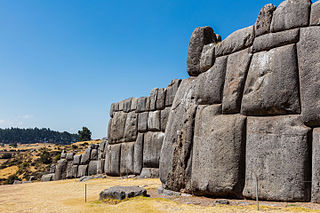
Cusco or Cuzco is a city in southeastern Peru, near the Sacred Valley of the Andes mountain range and the Huatanay river. It is the capital of the eponymous province and department. The city is the seventh most populous in Peru; in 2017, it had a population of 428,450. Its elevation is around 3,400 m (11,200 ft).

Machu Picchu is a 15th-century Inca citadel located in the Eastern Cordillera of southern Peru on a mountain ridge at 2,430 meters (7,970 ft). Often referred to as the "Lost City of the Incas", it is the most familiar icon of the Inca Empire. It is located in the Machupicchu District within the Urubamba Province above the Sacred Valley, which is 80 kilometers (50 mi) northwest of the city of Cusco. The Urubamba River flows past it, cutting through the Cordillera and creating a canyon with a subtropical mountain climate.
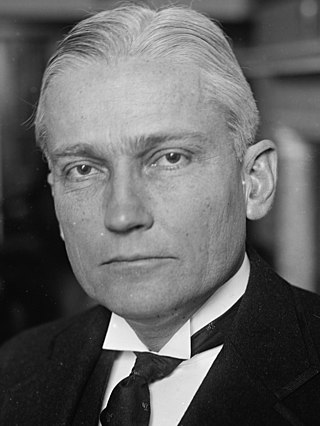
Hiram Bingham III was an American academic, explorer and politician. In 1911, he publicized the existence of the Inca citadel of Machu Picchu which he rediscovered with the guidance of local indigenous farmers. Later, Bingham served as the 69th Governor of Connecticut for a single day in 1925—the shortest term in history. He had been elected in 1924 as governor, but was also elected to the Senate and chose that position. He served as a member of the United States Senate until 1933.
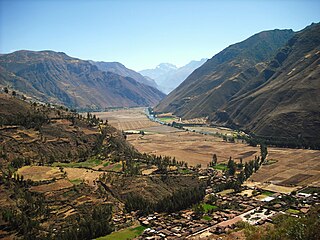
The Sacred Valley of the Incas, or the Urubamba Valley, is a valley in the Andes of Peru, north of the Inca capital of Cusco. It is located in the present-day Peruvian region of Cusco. In colonial documents it was referred to as the "Valley of Yucay". The Sacred Valley was incorporated slowly into the incipient Inca Empire during the period from 1000 to 1400.
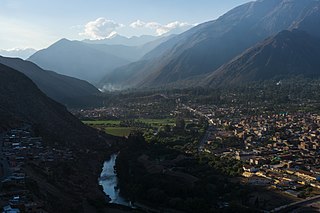
Urubamba is a small town in Peru, located near the Urubamba River under the snow-capped mountain Chicón. It is the capital of the district of the same name. Located one hour from Cusco, Urubamba is the largest town in the Sacred Valley of the Incas. It is also located near a number of significant ruins of the Inca Empire, including Machu Picchu. The sparse remains of the Inca palace, Quispiguanca, are within the town. Tourists often come through the town on their way to visit these sites.

Machupicchu or Machupicchu Pueblo, also known as Aguas Calientes, is a location in Peru situated in the Cusco Region, Urubamba Province. It is the seat of Machupicchu District. Machupicchu lies at the Vilcanota River. It is the closest access point to the historical site of Machu Picchu which is 6 kilometres (3.7 mi) away or about a 90-minute walk. There are many hotels and restaurants for tourists, as well as natural hot baths which gave the town its colloquial Spanish name, Aguas Calientes or hot water.

Alejandro Velasco Astete International Airport is an international airport located in the city of Cusco, in southeastern Peru. Cusco, a principal tourist attraction in Latin America, receives various domestic flights as well as some international flights. The runway is completely paved. It operates at limited capacity due to its precarious location near the city's center. Despite these limitations, the airport has consistently ranked as Peru's second most important air terminal, handling 3,004,412 national and international passengers in 2023, as reported by CORPAC.

PeruRail is a railway operator providing tourist, freight, and charter services in southern Peru. It was founded in 1999 by two Peruvian entrepreneurs and the British company Sea Containers.

Rail transport in Peru has a varied history. Peruvian rail transport has never formed a true network, primarily comprising separate lines running inland from the coast and built according to freight need rather than passenger need.

The Inca Bridge or Inka Bridge refers to one of two places related to access to Machu Picchu, in Peru.

Choquequirao is an Incan site in southern Peru, similar in structure and architecture to Machu Picchu. The ruins are buildings and terraces at levels above and below Sunch'u Pata, the truncated hill top. The hilltop was anciently leveled and ringed with stones to create a 30 by 50 m platform.

Inti Punku or Intipunku is an archaeological site in the Cusco Region of Peru that was once a fortress of the sacred city, Machu Picchu. It is now also the name of the final section of the Incan Trail between the Sun Gate complex and the city of Machu Picchu. It was believed that the steps were a control gate for those who enter and exited the Sanctuary.
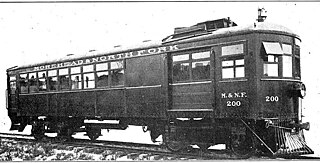
EIKON International is located in Montgomery, Alabama, and makes interurban cars, trolley cars and streetcars. EIKON also restores and manufactures other types of rail cars, including streetcars. EIKON emerged in 2008 as Edwards Rail Car Company ceased production of railcars at the Montgomery location.

The Inca Trail to Machu Picchu is a hiking trail in Peru that terminates at Machu Picchu. It consists of three overlapping trails: Mollepata, Classic, and One Day. Mollepata is the longest of the three routes with the highest mountain pass and intersects with the Classic route before crossing Warmiwañusqa. Located in the Andes mountain range, the trail passes through several types of Andean environments including cloud forest and alpine tundra. Settlements, tunnels, and many Incan ruins are located along the trail before ending the terminus at the Sun Gate on Machu Picchu mountain. The two longer routes require an ascent to beyond 4,200 metres (13,800 ft) above sea level, which can result in altitude sickness.

Patallacta, Llactapata or Q'ente Marka is an archaeological site in Peru located in the Cusco Region, Urubamba Province, Machupicchu District. It is situated southeast of the site Machu Picchu, at the confluence of the rivers Cusichaca and Vilcanota on a mountain named Patallacta.

Intihuatana at the archaeological site of Machu Picchu is a notable ritual stone associated with the astronomic clock or calendar of the Inca in South America. Machu Picchu was thought to have been built c. 1450 by the Sapa Inca Pachacuti as a country estate. In the late 16th century, the Viceroy Francisco de Toledo and the clergy destroyed those Intihuatana which they could find. They did so as they believed that the Incas' religion was a blasphemy and the religious significance of the Intihuatana could be a political liability. The Intihuatana of Machu Picchu was found intact by Bingham in 1911, indicating that the Spanish conquerors had not found it. Intihuatana was damaged on September 8, 2000 when a crane being used in an ad shoot toppled over and chipped off a piece of the granite.
Belmond Sanctuary Lodge is a small hotel situated at the entrance to the Machu Picchu Inca citadel. It is the only hotel at this World Heritage Site, and can be accessed by foot or by rail.
The Belmond Hiram Bingham is a luxury train operating day return trips from Poroy station outside Cusco to Aguas Calientes, the station for Machu Picchu in Peru.

Chinchero International Airport is an under construction international airport in the town of Chinchero, which is located in the district of the same name, in Cusco Region, Perú. It is planned to replace Alejandro Velasco Astete International Airport. Its altitude is 3,720 metres (12,200 ft) above sea level.
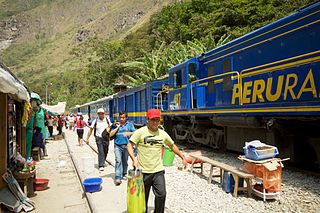
The Hydroelectric Station is a railway station located in the Machu Picchu District of the Urubamba Province in the Cusco Region, Peru. This station is the terminus of the Southern Railway - South Eastern Section and primarily serves the Machu Picchu Hydroelectric Power Plant. It is operated by Ferrocarril Trasandino and accommodates the "local train" service by PeruRail, which is exclusively for local residents or Peruvian citizens. Tourist trains do not reach this station as they end their journey at Aguas Calientes Station.


















